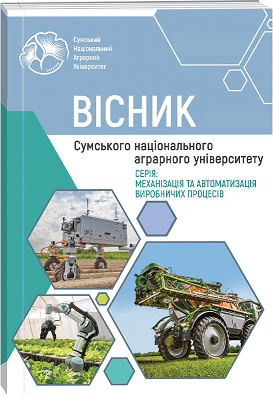REVIEW OF INNOVATIVE METHODS OF LEGUME PROCESSING AND THEIR IMPACT ON NUTRITIONAL VALUE AND FUNCTIONAL PROPERTIES
Abstract
This review article discusses various processing methods for pulses, including fermentation, extrusion, high-pressure processing, ultrasonication, microwave processing, and pulsed electromagnetic field processing. Pulses play an important role in human nutrition due to their high content of proteins, minerals and vitamins. They are integral components of a healthy, balanced diet, which is especially important given the rapid growth of the world's population, which needs to be provided with high-protein foods. However, traditional processing methods are labor-intensive and often result in nutrient loss. In contrast, innovative pulse processing technologies reduce anti-nutritional factors while improving sensory and functional qualities. Fermentation improves the digestibility of pulses by reducing phytates and tannins, increasing the bioavailability of minerals. Extrusion produces protein-rich products, but requires precise control to avoid nutrient loss. High-pressure processing extends the shelf life by preserving vitamins and minerals, making it valuable for ready-to-eat foods. Ultrasonication reduces cooking time and improves texture while retaining antioxidants. Microwaving reduces cooking time while helping to preserve vitamins such as folate and vitamin C. Pulsed electromagnetic fields offer a non-thermal preservation method, extending shelf life and maintaining protein quality. The combination of these methods can further enhance the nutritional value of pulse-based products through a synergistic effect. In addition, these technologies support product diversification by enabling the development of pulsebased snacks, meat substitutes, and fortified products tailored to modern consumer preferences. In general, innovative processing methods reduce heat treatment time, preserve proteins and reduce the content of antinutritional compounds such as phytates and lectins. They contribute to the achievement of sustainable development goals by reducing food waste and increasing production efficiency, while ensuring a stable supply of food with a high nutritional content. Therefore, further research and industrialization of advanced pulse processing methods is crucial to ensure a balance between environmental sustainability and economic efficiency. These technologies have the potential to meet global food needs while minimizing resource use, reducing environmental impact, and contributing to the creation of high quality, healthy foods.
References
2. Ruiz-Zambrano, N. L., Pérez-Carrillo, E., Serna-Saldívar, S. O., & Tejada-Ortigoza, V. (2023). Effect of thermal, nonthermal, and combined treatments on functional and nutritional properties of chickpeas. Critical Reviews in Food Science and Nutrition, 1–19. https://doi.org/10.1080/10408398.2023.2237577
3. Bender, D., Yamsaengsung, R., Waziiroh, E., Schoenlechner, R., & Jaeger, H. (2024). Effect of ultrasound‐assisted soaking on the hydration kinetics and physicochemical properties of chickpeas. International Journal of Food Science & Technology. https://doi.org/10.1111/ijfs.16916
4. Alajaji, S. A., & El-Adawy, T. A. (2006). Nutritional composition of chickpea (Cicer arietinum L.) as affected by microwave cooking and other traditional cooking methods. Journal of Food Composition and Analysis, 19(8), 806–812. https://doi.org/10.1016/j.jfca.2006.03.015
5. Bhargava, N., Mor, R. S., Kumar, K., & Sharanagat, V. S. (2021). Advances in application of ultrasound in food processing: A review. Ultrasonics Sonochemistry, 70, 105293. https://doi.org/10.1016/j.ultsonch.2020.105293
6. Ulloa, J. A., Enríquez López, K. V., Contreras Morales, Y. B., Rosas Ulloa, P., Ramírez Ramírez, J. C., & Ulloa Rangel, B. E. (2015). Effect of ultrasound treatment on the hydration kinetics and cooking times of dry beans (Phaseolus vulgaris). CyTA – Journal of Food, 1–9. https://doi.org/10.1080/19476337.2015.1024173
7. Perucini-Avendaño, M., Arzate-Vázquez, I., de Jesús Perea-Flores, M., Tapia-Maruri, D., Méndez-Méndez, J. V., Nicolás-García, M., & Dávila-Ortiz, G. (2024). Effect of cooking on structural changes in the common black bean (phaseolus vulgaris var. jamapa). Heliyon, Article e25620. https://doi.org/10.1016/j.heliyon.2024.e25620
8. Yeasmin, F., Prasad, P., & Sahu, J. K. (2024). Effect of ultrasound on physicochemical, functional and antioxidant properties of red kidney bean (Phaseolus vulgaris L.) proteins extract. Food Bioscience, 103599. https://doi.org/10.1016/j.fbio.2024.103599
9. Liu, S., Yin, H., Pickard, M., & Ai, Y. (2020). Influence of infrared heating on the functional properties of processed lentil flours: A study focusing on tempering period and seed size. Food Research International, 136, 109568. https://doi.org/10.1016/j.foodres.2020.109568
10. Han, L., Cao, S., Yu, Y., Xu, X., Cao, X., & Chen, W. (2021). Modification in physicochemical, structural and digestive properties of pea starch during heat-moisture process assisted by pre- and post-treatment of ultrasound. Food Chemistry, 360, 129929. https://doi.org/10.1016/j.foodchem.2021.129929
11. Aziznia, S., Askari, G., Emamdjomeh, Z., & Salami, M. (2024). Effect of ultrasonic assisted grafting on the structural and functional properties of mung bean protein isolate conjugated with maltodextrin through maillard reaction. International Journal of Biological Macromolecules, 254, 127616. https://doi.org/10.1016/j.ijbiomac.2023.127616
12. Kang, S., Zhang, J., Guo, X., Lei, Y., & Yang, M. (2022). Effects of Ultrasonic Treatment on the Structure, Functional Properties of Chickpea Protein Isolate and Its Digestibility In Vitro. Foods, 11(6), 880. https://doi.org/10.3390/foods11060880
13. Wang, Y., Wang, Y., Li, K., Bai, Y., Li, B., & Xu, W. (2020). Effect of high intensity ultrasound on physicochemical, interfacial and gel properties of chickpea protein isolate. LWT, 129, 109563. https://doi.org/10.1016/j.lwt.2020.109563
14. Rizzello, C. G., Hernández-Ledesma, B., Fernández-Tomé, S., Curiel, J. A., Pinto, D., Marzani, B., Coda, R., & Gobbetti, M. (2015). Italian legumes: Effect of sourdough fermentation on lunasin-like polypeptides. Microbial Cell Factories, 14(1). https://doi.org/10.1186/s12934-015-0358-6
15. Limón, R. I., Peñas, E., Torino, M. I., Martínez-Villaluenga, C., Dueñas, M., & Frias, J. (2015). Fermentation enhances the content of bioactive compounds in kidney bean extracts. Food Chemistry, 172, 343–352. https://doi.org/10.1016/j.foodchem.2014.09.084
16. Senanayake, D., Torley, P. J., Chandrapala, J., & Terefe, N. S. (2023). Microbial fermentation for improving the sensory, nutritional and functional attributes of legumes. Fermentation, 9(7), 635. https://doi.org/10.3390/fermentation9070635
17. Garrido-Galand, S., Asensio-Grau, A., Calvo-Lerma, J., Heredia, A., & Andrés, A. (2021). The potential of fermentation on nutritional and technological improvement of cereal and legume flours: A review. Food Research International, 145, 110398. https://doi.org/10.1016/j.foodres.2021.110398
18. Barba, F. J., Parniakov, O., Pereira, S. A., Wiktor, A., Grimi, N., Boussetta, N., Saraiva, J. A., Raso, J., Martin-Belloso, O., Witrowa-Rajchert, D., Lebovka, N., & Vorobiev, E. (2015). Current applications and new opportunities for the use of pulsed electric fields in food science and industry. Food Research International, 77, 773–798. https://doi.org/10.1016/j.foodres.2015.09.015
19. Jeyamkondan, S., Jayas, D. S., & Holley, R. A. (1999). Pulsed electric field processing of foods: A review. Journal of Food Protection, 62(9), 1088–1096. https://doi.org/10.4315/0362-028x-62.9.1088
20. Martínez, J. M., Delso, C., Álvarez, I., & Raso, J. (2020). Pulsed electric field‐assisted extraction of valuable compounds from microorganisms. Comprehensive Reviews in Food Science and Food Safety, 19(2), 530–552. https://doi.org/10.1111/1541-4337.12512
21. Advances in thermal and non-thermal food preservation. (2007). Wiley & Sons, Incorporated, John.
22. Alonso, R., Grant, G., Dewey, P., & Marzo, F. (2000). Nutritional assessment in vitro and in vivo of raw and extruded peas (pisumsativuml.). Journal of Agricultural and Food Chemistry, 48(6), 2286–2290. https://doi.org/10.1021/jf000095o
23. Urbano, G., Aranda, P., Gómez-Villalva, E., Frejnagel, S., Porres, J. M., Frías, J., Vidal-Valverde, C., & López-Jurado, M. (2003). Nutritional evaluation of pea (pisum sativuml.) protein diets after mild hydrothermal treatment and with and without added phytase. Journal of Agricultural and Food Chemistry, 51(8), 2415–2420. https://doi.org/10.1021/jf0209239
24. Peyrano, F., de Lamballerie, M., Avanza, M. V., & Speroni, F. (2021). Gelation of cowpea proteins induced by high hydrostatic pressure. Food Hydrocolloids, 111, 106191. https://doi.org/10.1016/j.foodhyd.2020.106191
25. Tas, A. A., & Shah, A. U. (2021). The replacement of cereals by legumes in extruded snack foods: Science, technology and challenges. Trends in Food Science & Technology, 116, 701–711. https://doi.org/10.1016/j.tifs.2021.08.016
26. Bessada, S. M., Barreira, J. C., & Oliveira, M. B. P. (2019). Pulses and food security: Dietary protein, digestibility, bioactive and functional properties. Trends in Food Science & Technology, 93, 53–68. https://doi.org/10.1016/j.tifs.2019.08.022
27. Rizzello, C. G., Hernández-Ledesma, B., Fernández-Tomé, S., Curiel, J. A., Pinto, D., Marzani, B., Coda, R., & Gobbetti, M. (2015). Italian legumes: Effect of sourdough fermentation on lunasin-like polypeptides. Microbial Cell Factories, 14(1). https://doi.org/10.1186/s12934-015-0358-6
28. Zuluaga, A. M., Mena-García, A., Soria Monzón, A. C., Rada-Mendoza, M., Chito, D. M., Ruiz-Matute, A. I., & Sanz, M. L. (2020). Microwave assisted extraction of inositols for the valorization of legume by-products. Lwt, 133, 109971. https://doi.org/10.1016/j.lwt.2020.109971
29. Sun, X., Ohanenye, I. C., Ahmed, T., & Udenigwe, C. C. (2020). Microwave treatment increased protein digestibility of pigeon pea (Cajanus cajan) flour: Elucidation of underlying mechanisms. Food Chemistry, 329, 127196. https://doi.org/10.1016/j.foodchem.2020.127196
30. Mahalaxmi, S., Himashree, P., Malini, B., & Sunil, C. K. (2022). Effect of microwave treatment on the structural and functional properties of proteins in lentil flour. Food Chemistry Advances, 1, 100147. https://doi.org/10.1016/j.focha.2022.100147
31. Mulla, M. Z., Subramanian, P., & Dar, B. N. (2022). Functionalization of legume proteins using high pressure processing: Effect on technofunctional properties and digestibility of legume proteins. Lwt, 158, 113106. https://doi.org/10.1016/j.lwt.2022.113106
32. Sosa, E. F., Thompson, C., Chaves, M. G., Acevedo, B. A., & Avanza, M. V. (2019). Legume seeds treated by high hydrostatic pressure: Effect on functional properties of flours. Food and Bioprocess Technology, 13(2), 323–340. https://doi.org/10.1007/s11947-019-02386-9
33. Hall, A. E., & Moraru, C. I. (2021). Structure and function of pea, lentil and faba bean proteins treated by high pressure processing and heat treatment. Lwt, 152, 112349. https://doi.org/10.1016/j.lwt.2021.112349
34. Gharibzahedi, S. M. T., & Smith, B. (2021). Effects of high hydrostatic pressure on the quality and functionality of protein isolates, concentrates, and hydrolysates derived from pulse legumes: A review. Trends in Food Science & Technology, 107, 466–479. https://doi.org/10.1016/j.tifs.2020.11.016
35. Semba, R. D., Ramsing, R., Rahman, N., Kraemer, K., & Bloem, M. W. (2021). Legumes as a sustainable source of protein in human diets. Global Food Security, 28, 100520. https://doi.org/10.1016/j.gfs.2021.100520
36. Foyer, C. H., Lam, H.-M., Nguyen, H. T., Siddique, K. H. M., Varshney, R. K., Colmer, T. D., Cowling, W., Bramley, H., Mori, T. A., Hodgson, J. M., Cooper, J. W., Miller, A. J., Kunert, K., Vorster, J., Cullis, C., Ozga, J. A., Wahlqvist, M. L., Liang, Y., Shou, H., ... Considine, M. J. (2016). Neglecting legumes has compromised human health and sustainable food production. Nature Plants, 2(8). https://doi.org/10.1038/nplants.2016.112
37. Yanni, A. E., Iakovidi, S., Vasilikopoulou, E., & Karathanos, V. T. (2023). Legumes: A vehicle for transition to sustainability. Nutrients, 16(1), 98. https://doi.org/10.3390/nu16010098
38. Mudryj, A. N., Yu, N., & Aukema, H. M. (2014). Nutritional and health benefits of pulses. Applied Physiology, Nutrition, and Metabolism, 39(11), 1197–1204. https://doi.org/10.1139/apnm-2013-0557
39. Hall, C., Hillen, C., & Garden Robinson, J. (2017). Composition, nutritional value, and health benefits of pulses. Cereal Chemistry Journal, 94(1), 11–31. https://doi.org/10.1094/cchem-03-16-0069-fi
40. Singh, B., Singh, J. P., Shevkani, K., Singh, N., & Kaur, A. (2016). Bioactive constituents in pulses and their health benefits. Journal of Food Science and Technology, 54(4), 858–870. https://doi.org/10.1007/s13197-016-2391-9
41. Nemecek, T., von Richthofen, J.-S., Dubois, G., Casta, P., Charles, R., & Pahl, H. (2008). Environmental impacts of introducing grain legumes into European crop rotations. European Journal of Agronomy, 28(3), 380–393. https://doi.org/10.1016/j.eja.2007.11.004
42. Sá, A. G. A., Silva, D. C. d., Pacheco, M. T. B., Moreno, Y. M. F., & Carciofi, B. A. M. (2021). Oilseed by-products as plant-based protein sources: Amino acid profile and digestibility. Future Foods, 3, 100023. https://doi.org/10.1016/j.fufo.2021.100023
43. Kamani, M. H., Neji, C., Fitzsimons, S. M., Fenelon, M. A., & Murphy, E. G. (2023). Unlocking the nutritional and functional potential of legume waste to produce protein ingredients. Critical Reviews in Food Science and Nutrition, 1–19. https://doi.org/10.1080/10408398.2023.2184322

 ISSN
ISSN  ISSN
ISSN 



